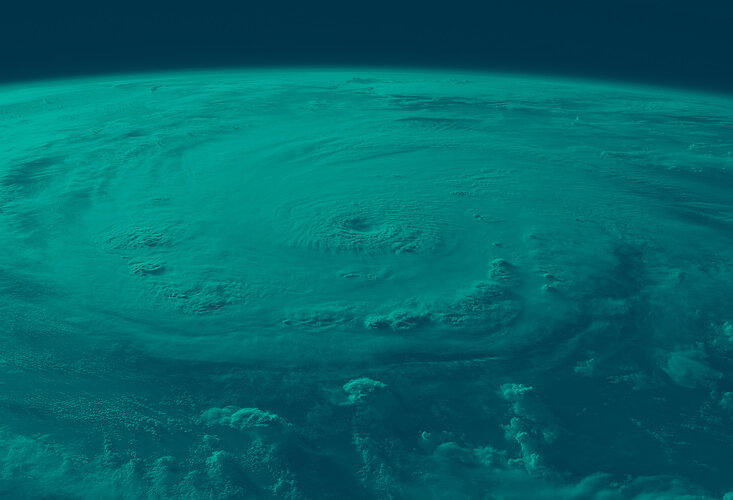Flawless launch of a super Meteosat
ESA PR 58-2002 Almost 25 years after the November 1977 launch of the very first Meteosat, the first representative of the next generation (MSG-1) of European weather satellites has been placed in orbit and is being made ready to lend new dimensions to the monitoring of our planet's climate.
On 28 August at 1945h local time (2245h GMT), a European Ariane-5 launcher lifted off from the Guiana Space Centre, Europe's spaceport at Kourou, French Guiana. The two payloads were placed in geostationary transfer orbit. One of these was the first satellite to be launched under the Meteosat Second Generation programme. Controlled from the European Space Agency's operations centre at Darmstadt, Germany, MSG-1 will now make a series of manoeuvres using its onboard propulsion system which will take it to its definitive geostationary orbit a few weeks hence. Responding to the launch, José Achache, ESA Director of Earth Observation, said: "With the world's political leaders gathered in Johannesburg to discuss the requirements for sustainable global development of our planet, ESA is proud to have deployed this satellite on behalf of Eumetsat and for the benefit of countless users. It is going to improve weather forecasting, our understanding of climate change and the issue of the planet's water resources".

Built by Alcatel Space Industries, as prime contractor, and a team of over 50 European companies, MSG-1 was developed by ESA on behalf of Eumetsat, the European meteorological satellite organisation.
Eumetsat will be taking over MSG-1 at the end of September, following in-orbit checking of its systems, and will then proceed with acceptance of the payload. The first image from the satellite is expected by the end of October. About a year after launch, MSG-1 will commence operational service above the equator, at 0° longitude, taking over from Meteosat-7 as the main weather- and climate-monitoring satellite.
Two and a half times larger than the Meteosat-1 to -7 series, MSG-1 is a cylindrical satellite 3.22 metres in diameter and 3.74 metres in height. Its mass on lift-off was 2 tonnes, almost half accounted for by the propellant needed to place it on station and keep it there during its seven-year mission.

The MSG programme aims to build on Meteosat's success to date by flying new, more powerful and accurate instruments for continuous observation of the Earth's atmosphere through to the year 2014. The MSG satellites are going to carry on the uninterrupted monitoring performed by their predecessors over the past quarter of a century, generating a multitude of data essential to the understanding and modelling of our planet's climatic activity.
The two main instruments on board are the SEVIRI and GERB radiometers.
SEVIRI (Spinning Enhanced Visible & Infrared Imager) will be able to supply, at intervals of 15 minutes (compared to 30 with the first generation), images of the hemisphere observed by the satellite in 12 different visible and infrared wavelengths (a fourfold increase). This enrichment of the spectrum of observations is a major advance, making for improvement of numerical climate modelling. By delivering data at twice the previous frequency, MSG-1 will make it easier for climatologists and meteorologists to detect the start of sudden weather phenomena, such as snow, thunderstorms and fog. Similarly, with the improvement of image resolution in the visible spectrum, to 1 km from 2.5 km previously, observation and monitoring of local phenomena will be improved.

The GERB (Geostationary Earth Radiation Budget) radiometer will supply crucial data on the Earth's radiation budget - the balance between the incoming radiation from the sun and the radiation returned to space. The radiation budget, about which much has yet to be learnt, plays a key role in climate change.
MSG-1 is also flying a payload for receiving and relaying, almost in real time, data from automated stations on the ground. In addition, a special transponder will relay distress signals from ships, aircraft and any other vehicles equipped with one of the beacons used by the COSPAS-SARSAT international search and rescue system.
MSG-1 is to be followed by two identical satellites, for which Eumetsat will be fully responsible. MSG-2 is currently scheduled for launch in early 2005, MSG-3 in spring 2009. Consideration is being given to building a fourth satellite to maintain continuity of the programme beyond 2014.
For further information, please contact:
ESA Media Relations Service
Tel.:+33(0)1.53.69.7155
Fax:+33(0)1.53.69.7690















 Germany
Germany
 Austria
Austria
 Belgium
Belgium
 Denmark
Denmark
 Spain
Spain
 Estonia
Estonia
 Finland
Finland
 France
France
 Greece
Greece
 Hungary
Hungary
 Ireland
Ireland
 Italy
Italy
 Luxembourg
Luxembourg
 Norway
Norway
 The Netherlands
The Netherlands
 Poland
Poland
 Portugal
Portugal
 Czechia
Czechia
 Romania
Romania
 United Kingdom
United Kingdom
 Slovenia
Slovenia
 Sweden
Sweden
 Switzerland
Switzerland


























